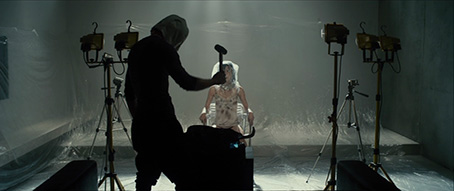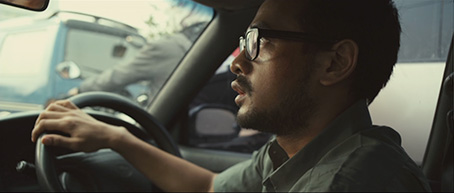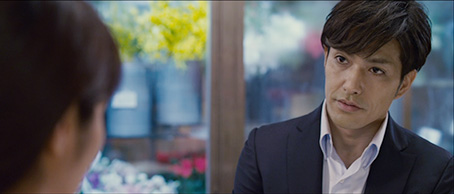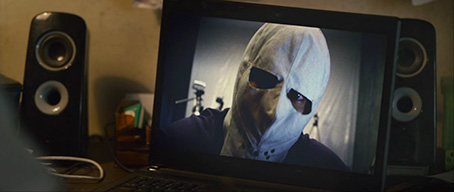|
When it comes to portraying the nastiness of serial killers on film, no one does it quite like Far Eastern cinema. If you're looking for validation of that claim, you can start with South Korean favourites The Chaser [Chugyeogja] and I Saw the Devil [Akmareul boatda], and if you survive them, you may – and I do mean may – just about be ready for the gut-wrenching horrors of Japanese filmmaker Sono Shion's Cold Fish [Tsumetai nettaigyo]. Don't say I didn't warn you. When I approach any recent film from the Far East in which a serial killer is featured, I expect to be taken places that western films would generally fear to tread. With that in mind, two early of scenes in the unambiguously titled Indonesian thriller Killers are likely to have a portion of even a prepared audience sucking air through their teeth.
Following an energetic sexual encounter, a young Japanese woman, her body plastered with small cuts, runs terrified through woodland. She stumbles and recovers, but is instantly accosted by a masked man who pulls a plastic bag over her head. When we next see her she's tied to a chair in a polythene-lined room that has a number of lights and video cameras aimed directly at her. The masked man calmly intimidates her and then kills her by striking her still covered head with a club hammer. He then removes the bag and films the results of his endeavours, after which he edits the footage and uploads the results to a YouTube-like video-sharing site from an internet café, making sure to wipe his prints from the keyboard before leaving. Still with me? Well we're not finished yet.

When he returns home later, he puts the girl's body in a bath and soaks her in acid, the effects of which are briefly but horrifyingly suggested by a blink-and-you'll-miss-it use of CGI. When the process is almost complete, he leans over to move a protruding arm and has to break its remains from the side of the bathtub. At this point I actually let out a yelp. He then scrapes the remaining bone fragments and gore from the tub and scoops them into a bag, wipes every trace of the victim from the apartment, and goes out to hit a few golf balls and eye up a girl who might become his next victim. His name is Nomura Shuhei, and he has all the outward appearance of cultured respectability.
Midway between those two scenes, we're introduced to Indonesian TV journalist Bayu Aditya, who when we first encounter him is watching Nomura's snuff movie on the video sharing site to which it has been posted. Why he is doing so is not really clear. Is he researching a story or has he just stumbled on the video by chance? It's hard to gauge from his reaction, which appears to be a car-crash marriage of horror and fascination. By the look of the viewing counter and the comments section at the side, he's far from the first to appreciate Nomura's handiwork.
The next day, Bayu is assigned to shoot a news report on corrupt businessman and political hopeful Dharma, a man who repeatedly dodges conviction and is now accused of beating up his wife. There is clearly some bad blood between him and Bayu, whose journalistic career took a pounding when his efforts to expose Dharma's criminal activities were somehow sabotaged. When he confronts Dharma and his sizeable entourage in an underground car park, he takes a beating for his trouble and has his camera smashed. Later that day, after visiting his estranged wife and daughter, he is hijacked by a crooked taxi driver and his burly accomplice, who rob and attempt to sexually assault him. It all proves too much for Bayu, whose pent-up anger and frustration explodes, and in the struggle that follows he grabs a gun from his assailants and fatally shoots them both. Traumatised by the encounter, he eventually returns to the cab to retrieve his money and mobile phone, which he uses to film the bloody consequences of this fateful encounter. Later he uploads the footage to the same video-sharing site used by Namura, and the following day is sent an anonymous message inviting him to a private chat room. When he responds that evening, he finds himself in a text chat with Namura, who has tracked Bayu down after seeing his video and appears keen to prepare him for his second kill.

It's a grimly seductive setup, and there's a lot more going on here than a few dark thrills. When Bayu does kill again, his murders prove to be the flipside of Nomura's ruthless efficiency, specifically targeted victims of his ire who either fight back unexpectedly or are not in the location they were thought to be, which results in the wrong person being shot and Bayu only escaping by the skin of his teeth in the pandemonium that ensues. Nomura is in essence the professional serial killer and Bayu the bumbling amateur, goaded into committing crimes by his more experienced counterpart and seemingly unaware of the likely consequences of his actions. In this respect, the film explores the potential killer that may or may not lie dormant in all of us, something that Nomura appears to recognise in others and attempts to tease out. It's key to his attraction to pretty young flower shop owner Hisae, who first catches his attention when he spots her trying to apologetically abandon her autistic younger brother Soichi one night by leaving him in traffic to be hit by a car. Even the bond he subsequently forms with Soichi is driven by his desire to encourage the worst in others, as illustrated by the sequence in which he the gives boy a pep talk about standing up to bullies, then hands him a stun gun and encourages him to hurt his tormentors "again and again." "Till they die?" the young boy asks, which Nomura clearly takes as a positive sign.
Having quickly and efficiently painted Nomura in the blackest of colours, directors Kimo Stamboel and Timo Tjahjanto (under their regular pseudonym of The Mo Brothers) then throw a bit of a curve ball by inviting us to intermittently side with him, in the process playing some unsettling but effective games with audience allegiance. This is at its most intriguing during Nomura's developing relationship with Hisae, where Nomura is bashfully polite and actually rather likeable. Yet their first conversation is clouded by the expectation that he has targeted her as his next victim, a fear that is dispelled a short while later when a different girl is shown to have been lured into his web. The unpredictability and extremity of Nomura's actions colour even friendly encounters with the prospect of danger. Thus, when he upsets Shuhei and she runs from the room, it only takes a glance at a pair of pincers to have you fearing the use to which he may put them. It's typical of the film's complex layering and intricate structure that we're twice misdirected by the unpleasant possibilities offered by this everyday tool, whose existence we've almost forgotten about by the time it is suddenly and violently put to use.

Yet our knowledge of the very real threat that Nomura represents also provides an occasional sense of satisfaction or anticipation, allowing us to be amused when he quietly threatens an old man for angrily berating a group of children, or to root for him when he takes a beating from the pimp of a prostitute he has targeted but whom circumstances have forced him to release. This alliance with the dark side peaks when Nomura takes revenge against those he believes have wronged him. Just seconds after he has secreted the unconscious body of a girl in his car, he is approached by what may well be the nicest plain-clothes policeman in Japan about a parking violation, and I actually became nervous that he'd be found out. The filmmakers then take this a very risky step further by having the scene take a blackly farcical turn, as the nice cop converses with his dozy superior, unaware that right behind them the girl has awoken and that Nomura is fighting to force her back into the truck of the car. Enjoy this light moment, it's the last laugh you'll get before the film starts its headlong plunge into the abyss. What follows is as tense, disturbing and punishing a final act as I've watched all year.
Not everything works. Bayu's battle with the taxi driver and his unpleasant cohort is not as clearly filmed as it could be, and the scene in which he manages to repeatedly give a small army of Dharma's black-clad goons the slip is seriously hard to swallow. One can only presume that this cack-handed band of supposedly elite bodyguards carry no weapons and soaked their hands in Vaseline before attempting to give chase, so hopeless are they at grabbing and keeping hold of their prey – if these guys are supposed to be Dharma's protection, it's frankly amazing he's lived as long as he has. Other elements have a somewhat familiar ring. Namura's Spartan apartment and the chamber music that accompanies his post-murder clean-ups and grisly looking meals have a distinctly Hannibal ring, something carried through to the casting of Kitamura Kazuki, who surely would be first in line for the title role should they ever franchise that series for a Japanese remake. The thing that drives Bayu to commit his second killing is also a well-worn moral high ground favourite, but is well enough handled here to not feel like the cheap shortcut to murder justification for which it is too often employed.

For the most part, however, Killers delivers on the expectations of its building reputation and no-nonsense title, and then some. It's prepared to take its time but never feels like it's ambling, and there's more than enough going on here, both on and underneath the surface, to justify the two-and-a-quarter hour running time. Despite the very dark places it repeatedly takes you, it's an ultimately rewarding experience, particularly in its almost offhand suggestion that social media is becoming the perfect platform for the broadcast and consumption of true-life horror. Steel yourself up and see it. Just don't expect to come through it completely undamaged.
This is one of those films that would really benefit from a crisp HD transfer, heightening the reality of the horror and the sterile nature of Nomura's apartment. And that may well be what it gets on Lionsgate's UK Blu-ray, but unfortunately we were sent the DVD review disc instead, so I can't confirm that until I get my hands on the HD version. The DVD transfer is certainly strong enough by SD standards – the contrast is well balanced, the black levels solid, the daylight colours largely naturalistic (now there's a rare sight), the detail good and the picture spotless. The framing is 2.35:1 anamorphic.
The Dolby 5.1 surround track is, as expected, clearly mixed and with a strong dynamic range. Subtle use is made of the surround speakers for ambient sound, but they vividly spring to life during the visual and sonic distortions of Bayu's anxiety attack at a family dinner, where the soundtrack dances expressively around the room. Action scenes are also sometimes dynamically rendered, and the dance music in the night club that Nomura enters when looking for revenge is explosive in is volume, clarity, bass punch and spread.

Unusually for a foreign language film, optional English subtitles and English subtitles for the hearing impaired are both available. It's worth noting that this is a multi-lingual film, with dialogue in Indonesian, Japanese and English. Almost all written language is in English, the common ground language between the two killers.
Not a thing. Given that one of the executive producers was Gareth Evans, and considering how well featured the recently released Entertainment One Blu-ray of his dynamite The Raid 2 was, this is seriously disappointing.
Not one for the timid. Seriously, I mean it. If you're in any way disturbed by screen violence or films that trick you into believing everything will be fine only to then trip you up and beat you around the head with their plot twists, then please don't rent or buy this film and then accuse me of ruining your life for recommending it. But if you've already acquainted yourself with the dark side of Eastern serial killer cinema and made it through unscathed, then Killers has a great deal to offer. You may need a drink afterwards, but if you're anything like me you'll be running it again just a few days later.
Lionsgate's DVD sports a decent transfer and a solidly mixed soundtrack but not a whisper in the way of extra features. On this score alone I'll be keeping an eye on any future American disc release, and I'll update the picture and sound sections here if I get my hands on the UK Blu-ray. On the basis of the film alone, this comes recommended, albeit with the above caution in mind.
|